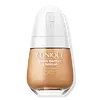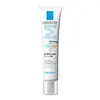Clinique Even Better Clinical Serum Foundation Broad Spectrum SPF 25 Versus La Roche-Posay Effaclar Duo+M Unifiant Tinted Care
What's inside
What's inside
 Key Ingredients
Key Ingredients

 Benefits
Benefits

 Concerns
Concerns

 Ingredients Side-by-side
Ingredients Side-by-side

Dimethicone
EmollientWater
Skin ConditioningPEG-10 Dimethicone
Skin ConditioningButylene Glycol
HumectantVinyl Dimethicone/Methicone Silsesquioxane Crosspolymer
Phenyl Trimethicone
Skin ConditioningIsododecane
EmollientButyloctyl Salicylate
Skin ConditioningIsodecyl Isononanoate
EmollientLauryl PEG-9 Polydimethylsiloxyethyl Dimethicone
Skin ConditioningAlcohol Denat.
AntimicrobialDimethicone/Vinyl Dimethicone Crosspolymer
Skin ConditioningHydrated Silica
AbrasiveAscorbyl Glucoside
AntioxidantTetrahexyldecyl Ascorbate
AntioxidantMagnesium Ascorbyl Phosphate
AntioxidantSodium Hyaluronate
HumectantTocopheryl Acetate
AntioxidantLaminaria Saccharina Extract
Skin ProtectingPolygala Senega Root Extract
RefreshingBeta Vulgaris Extract
Skin ProtectingNymphaea Alba Root Extract
Skin ConditioningCamellia Sinensis Leaf Extract
AntimicrobialSalvia Hispanica Seed Extract
EmollientSaccharum Officinarum Extract
MoisturisingDimethoxytolyl Propylresorcinol
AntioxidantCaffeine
Skin ConditioningNiacinamide
SmoothingSalicylic Acid
MaskingLinoleic Acid
CleansingTocopherol
AntioxidantLactoperoxidase
StabilisingGlucose Oxidase
StabilisingLactobacillus Ferment
Skin ConditioningGlycyrrhetinic Acid
Skin ConditioningCholesterol
EmollientJojoba Esters
EmollientGlucose
HumectantPolysilicone-11
Laureth-7
EmulsifyingTrimethylsiloxysilicate
EmollientSorbitan Sesquioleate
EmulsifyingLecithin
EmollientXanthan Gum
EmulsifyingSilica
AbrasiveCaprylyl Glycol
EmollientDimethicone/PEG-10/15 Crosspolymer
Disteardimonium Hectorite
StabilisingTriethoxycaprylylsilane
Alumina
AbrasivePropylene Carbonate
SolventDipropylene Glycol
HumectantSodium Chloride
MaskingSodium Hydroxide
BufferingCitric Acid
BufferingPotassium Phosphate
BufferingTetrasodium EDTA
Sodium Citrate
BufferingPotassium Sorbate
PreservativePhenoxyethanol
PreservativeMica
Cosmetic ColorantCI 77891
Cosmetic ColorantCI 77491
Cosmetic ColorantCI 77492
Cosmetic ColorantCI 77499
Cosmetic ColorantDimethicone, Water, PEG-10 Dimethicone, Butylene Glycol, Vinyl Dimethicone/Methicone Silsesquioxane Crosspolymer, Phenyl Trimethicone, Isododecane, Butyloctyl Salicylate, Isodecyl Isononanoate, Lauryl PEG-9 Polydimethylsiloxyethyl Dimethicone, Alcohol Denat., Dimethicone/Vinyl Dimethicone Crosspolymer, Hydrated Silica, Ascorbyl Glucoside, Tetrahexyldecyl Ascorbate, Magnesium Ascorbyl Phosphate, Sodium Hyaluronate, Tocopheryl Acetate, Laminaria Saccharina Extract, Polygala Senega Root Extract, Beta Vulgaris Extract, Nymphaea Alba Root Extract, Camellia Sinensis Leaf Extract, Salvia Hispanica Seed Extract, Saccharum Officinarum Extract, Dimethoxytolyl Propylresorcinol, Caffeine, Niacinamide, Salicylic Acid, Linoleic Acid, Tocopherol, Lactoperoxidase, Glucose Oxidase, Lactobacillus Ferment, Glycyrrhetinic Acid, Cholesterol, Jojoba Esters, Glucose, Polysilicone-11, Laureth-7, Trimethylsiloxysilicate, Sorbitan Sesquioleate, Lecithin, Xanthan Gum, Silica, Caprylyl Glycol, Dimethicone/PEG-10/15 Crosspolymer, Disteardimonium Hectorite, Triethoxycaprylylsilane, Alumina, Propylene Carbonate, Dipropylene Glycol, Sodium Chloride, Sodium Hydroxide, Citric Acid, Potassium Phosphate, Tetrasodium EDTA, Sodium Citrate, Potassium Sorbate, Phenoxyethanol, Mica, CI 77891, CI 77491, CI 77492, CI 77499
Water
Skin ConditioningGlycerin
HumectantIsocetyl Stearate
EmollientIsopropyl Isostearate
EmollientNiacinamide
SmoothingIsopropyl Lauroyl Sarcosinate
Skin ConditioningAmmonium Polyacryloyldimethyl Taurate
Emulsion StabilisingOryza Sativa Starch
AbsorbentGlyceryl Stearate Se
EmulsifyingSodium Hydroxide
BufferingTrisodium Ethylenediamine Disuccinate
Salicylic Acid
MaskingSilica Silylate
EmollientPoloxamer 338
EmulsifyingMaltodextrin
AbsorbentPolysorbate 80
EmulsifyingMannose
HumectantPentylene Glycol
Skin ConditioningZinc PCA
HumectantPunica Granatum Pericarp Extract
Skin ConditioningIsohexadecane
Emollient2-Oleamido-1,3-Octadecanediol
Skin ConditioningCapryloyl Salicylic Acid
ExfoliatingCaprylyl Glycol
EmollientPiroctone Olamine
PreservativeMyristyl Myristate
EmollientAcrylamide/Sodium Acryloyldimethyltaurate Copolymer
Emulsion StabilisingParfum
MaskingSorbitan Oleate
EmulsifyingPotassium Cetyl Phosphate
EmulsifyingVitreoscilla Ferment
Skin ConditioningCitric Acid
BufferingCI 77891
Cosmetic ColorantCI 77491
Cosmetic ColorantCI 77492
Cosmetic ColorantCI 77499
Cosmetic ColorantMica
Cosmetic ColorantWater, Glycerin, Isocetyl Stearate, Isopropyl Isostearate, Niacinamide, Isopropyl Lauroyl Sarcosinate, Ammonium Polyacryloyldimethyl Taurate, Oryza Sativa Starch, Glyceryl Stearate Se, Sodium Hydroxide, Trisodium Ethylenediamine Disuccinate, Salicylic Acid, Silica Silylate, Poloxamer 338, Maltodextrin, Polysorbate 80, Mannose, Pentylene Glycol, Zinc PCA, Punica Granatum Pericarp Extract, Isohexadecane, 2-Oleamido-1,3-Octadecanediol, Capryloyl Salicylic Acid, Caprylyl Glycol, Piroctone Olamine, Myristyl Myristate, Acrylamide/Sodium Acryloyldimethyltaurate Copolymer, Parfum, Sorbitan Oleate, Potassium Cetyl Phosphate, Vitreoscilla Ferment, Citric Acid, CI 77891, CI 77491, CI 77492, CI 77499, Mica
 Reviews
Reviews

Alternatives
Ingredients Explained
These ingredients are found in both products.
Ingredients higher up in an ingredient list are typically present in a larger amount.
Caprylyl Glycol is a humectant and emollient, meaning it attracts and preserves moisture.
It is a common ingredient in many products, especially those designed to hydrate skin. The primary benefits are retaining moisture, skin softening, and promoting a healthy skin barrier.
Though Caprylyl Glycol is an alcohol derived from fatty acids, it is not the kind that can dry out skin.
This ingredient is also used as a preservative to extend the life of products. It has slight antimicrobial properties.
Learn more about Caprylyl GlycolCi 77491 is also hydrated iron III oxide. It's sole purpose is to give a red/pink hue to products.
Iron III oxides are classified as inorganic chemicals for coloring.
Synthetically created Ci 77491 is considered safer than those naturally found. This is because the synthetically created version may contain less impurities. Iron oxides are generally non-toxic and non-allergenic.
Learn more about CI 77491Ci 77492 is also hydrated iron III oxide. It's sole purpose is to give a yellow hue to products.
Iron III oxides are classified as inorganic chemicals for coloring.
Synthetically created Ci 77492 is considered safer than those naturally found. This is because the synthetically created version may contain less impurities. Iron oxides are generally non-toxic and non-allergenic.
Learn more about CI 77492Ci 77499 is also hydrated iron III oxide. It is created from mixing red and black iron oxides. This helps give shades of darkness to a product.
Iron III oxides are classified as inorganic chemicals for coloring.
Ci 77891 is a white pigment from Titanium dioxide. It is naturally found in minerals such as rutile and ilmenite.
It's main function is to add a white color to cosmetics. It can also be mixed with other colors to create different shades.
Ci 77891 is commonly found in sunscreens due to its ability to block UV rays.
Learn more about CI 77891Citric Acid is an alpha hydroxy acid (AHA) naturally found in citrus fruits like oranges, lemons, and limes.
Like other AHAs, citric acid can exfoliate skin by breaking down the bonds that hold dead skin cells together. This helps reveal smoother and brighter skin underneath.
However, this exfoliating effect only happens at high concentrations (20%) which can be hard to find in cosmetic products.
Due to this, citric acid is usually included in small amounts as a pH adjuster. This helps keep products slightly more acidic and compatible with skin's natural pH.
In skincare formulas, citric acid can:
While it can provide some skin benefits, research shows lactic acid and glycolic acid are generally more effective and less irritating exfoliants.
Most citric acid used in skincare today is made by fermenting sugars (usually from molasses). This synthetic version is identical to the natural citrus form but easier to stabilize and use in formulations.
Read more about some other popular AHA's here:
Learn more about Citric AcidMica is a naturally occurring mineral used to add shimmer and color in cosmetics. It can also help improve the texture of a product or give it an opaque, white/silver color.
Serecite is the name for very fine but ragged grains of mica.
This ingredient is often coated with metal oxides like titanium dioxide. Trace amounts of heavy metals may be found in mica, but these metals are not harmful in our personal products.
Mica has been used since prehistoric times throughout the world. Ancient Egyptian, Indian, Greek, Roman, Aztec, and Chinese civilizations have used mica.
Learn more about MicaNiacinamide is a multitasking form of vitamin B3 that strengthens the skin barrier, reduces pores and dark spots, regulates oil, and improves signs of aging.
And the best part? It's gentle and well-tolerated by most skin types, including sensitive and reactive skin.
You might have heard of "niacin flush", or the reddening of skin that causes itchiness. Niacinamide has not been found to cause this.
In very rare cases, some individuals may not be able to tolerate niacinamide at all or experience an allergic reaction to it.
If you are experiencing flaking, irritation, and dryness with this ingredient, be sure to double check all your products as this ingredient can be found in all categories of skincare.
When incorporating niacinamide into your routine, look out for concentration amounts. Typically, 5% niacinamide provides benefits such as fading dark spots. However, if you have sensitive skin, it is better to begin with a smaller concentration.
When you apply niacinamide to your skin, your body converts it into nicotinamide adenine dinucleotide (NAD). NAD is an essential coenzyme that is already found in your cells as "fuel" and powers countless biological processes.
In your skin, NAD helps repair cell damage, produce new healthy cells, support collagen production, strengthen the skin barrier, and fight environmental stressors (like UV and pollution).
Our natural NAD levels start to decline with age, leading to slower skin repair, visible aging, and a weaker skin barrier. By providing your skin niacinamide, you're recharging your skin's NAD levels. This leads to stronger, healthier, and younger looking skin.
Another name for vitamin B3 is nicotinamide. This vitamin is water-soluble and our bodies don't store it. We obtain Vitamin B3 from either food or skincare. Meat, fish, wheat, yeast, and leafy greens contain vitamin B3.
The type of niacinamide used in skincare is synthetically created.
Learn more about NiacinamideSalicylic Acid (also known as beta hydroxy acid or BHA) is a well-known ingredient for treating skin that struggles with acne and clogged pores. It exfoliates both the skin's surface and deep within the pores to help clear out buildup, control oil, and reduce inflammation.
Unlike AHAs (alpha hydroxy acids), salicylic acid is oil-soluble. This allows it to penetrate into pores which makes it especially effective for treating blackheads and preventing future breakouts.
Salicylic acid is also known for its soothing properties. It has a similar structure to aspirin and can calm inflamed or irritated skin, making it a good option for acne-prone skin that is also sensitive.
Concentrations of 0.5-2% are recognized by the U.S. FDA as an over-the-counter topical acne product.
It can cause irritation and/or dryness if one's skin already has a compromised moisture barrier, so it's best to focus on repairing that before introducing this ingredient into your routine.
While salicylic acid does not increase sun sensitivity, it’s still important to wear sunscreen daily to protect your skin.
If you are looking for the ingredient called BHA or Butylated Hydroxyanisole, click here.
Learn more about Salicylic AcidSodium Hydroxide is also known as lye or caustic soda. It is used to adjust the pH of products; many ingredients require a specific pH to be effective.
In small amounts, sodium hydroxide is considered safe to use. However, large amounts may cause chemical burns due to its high alkaline.
Your skin has a natural pH and acid mantle. This acid mantle helps prevent harmful bacteria from breaking through. The acid mantle also helps keep your skin hydrated.
"Alkaline" refers to a high pH level. A low pH level would be considered acidic.
Learn more about Sodium HydroxideWater. It's the most common cosmetic ingredient of all. You'll usually see it at the top of ingredient lists, meaning that it makes up the largest part of the product.
So why is it so popular? Water most often acts as a solvent - this means that it helps dissolve other ingredients into the formulation.
You'll also recognize water as that liquid we all need to stay alive. If you see this, drink a glass of water. Stay hydrated!
Learn more about Water